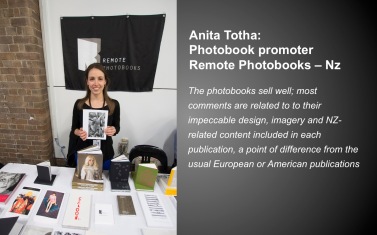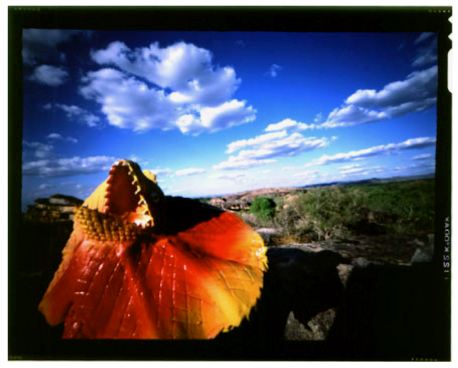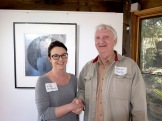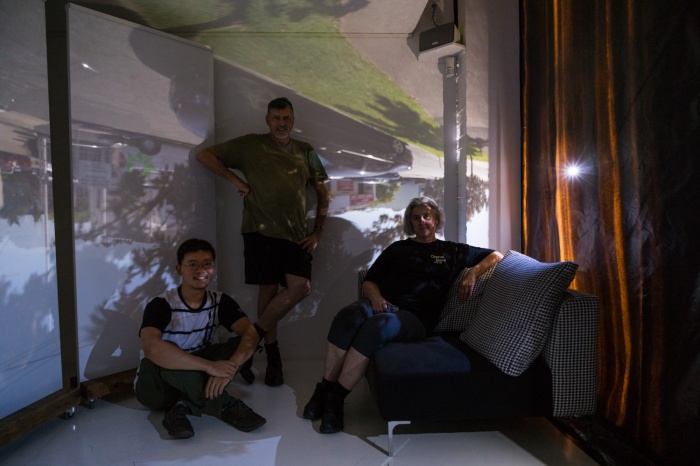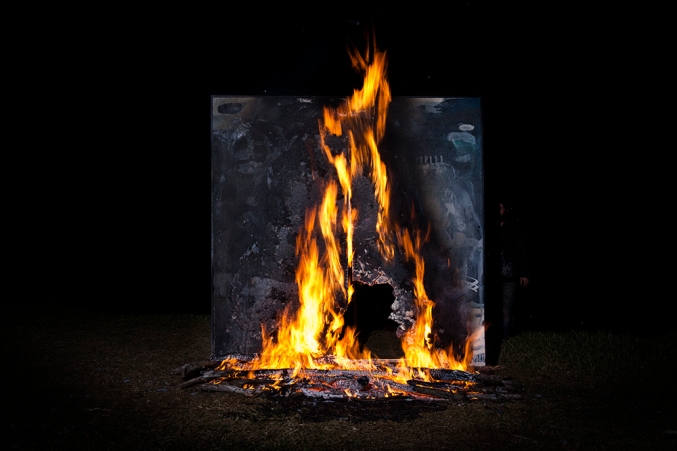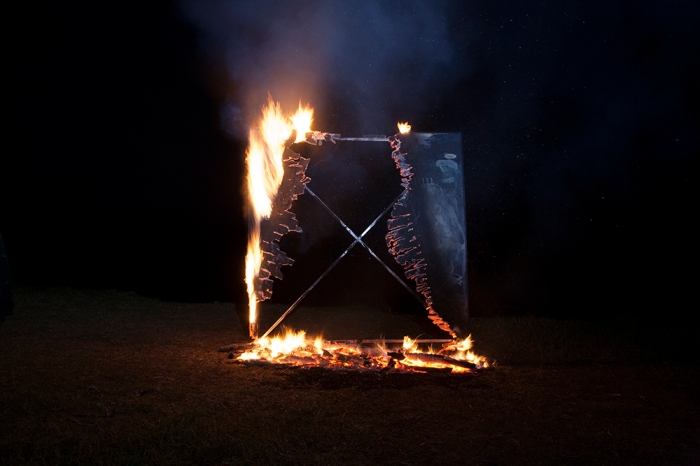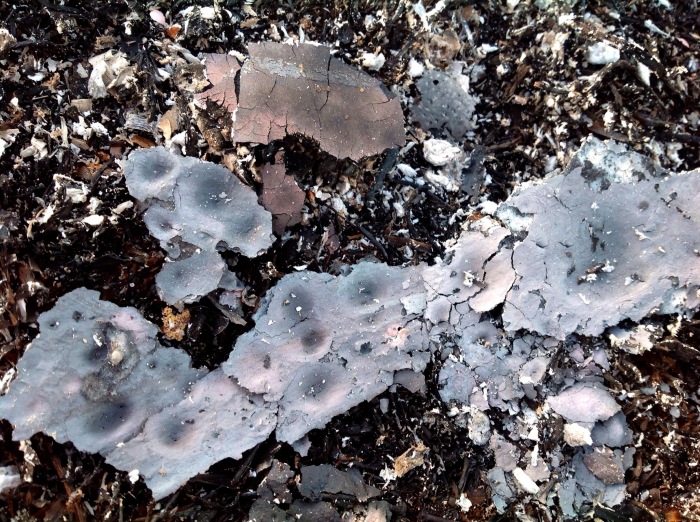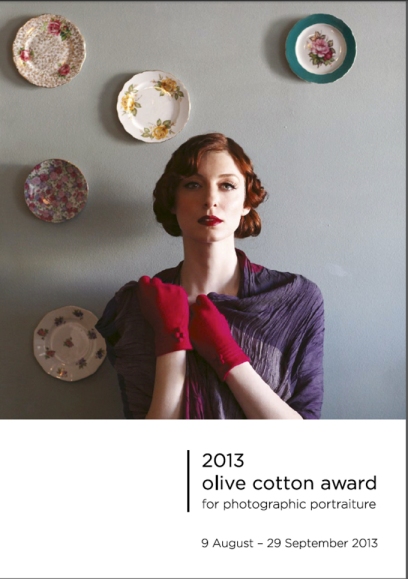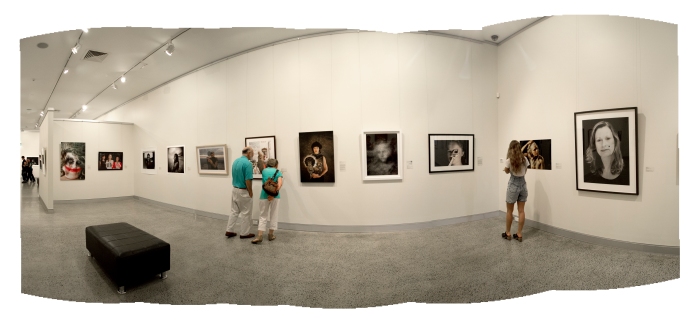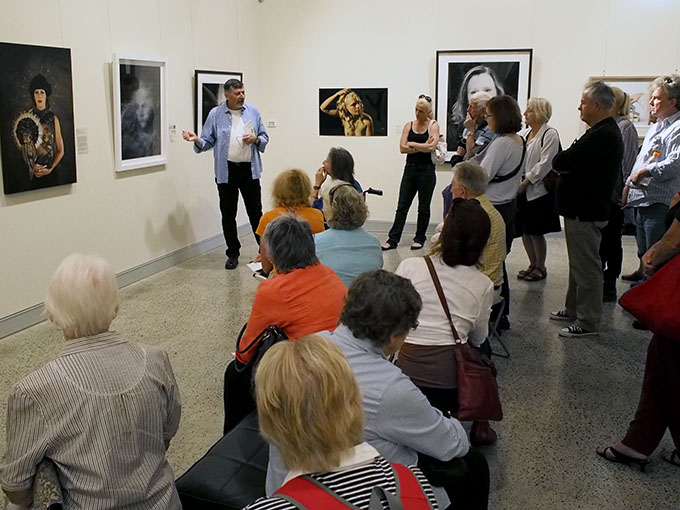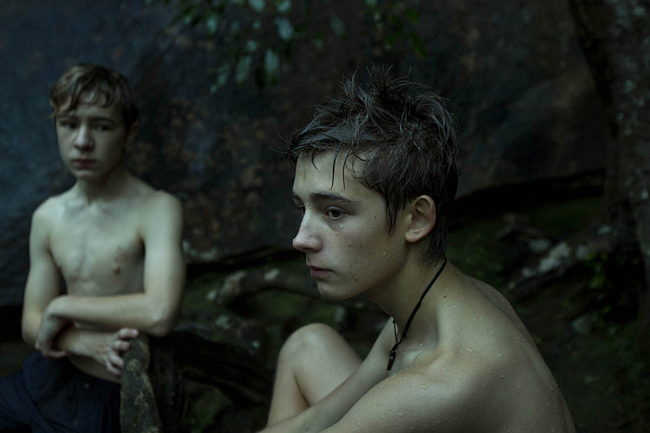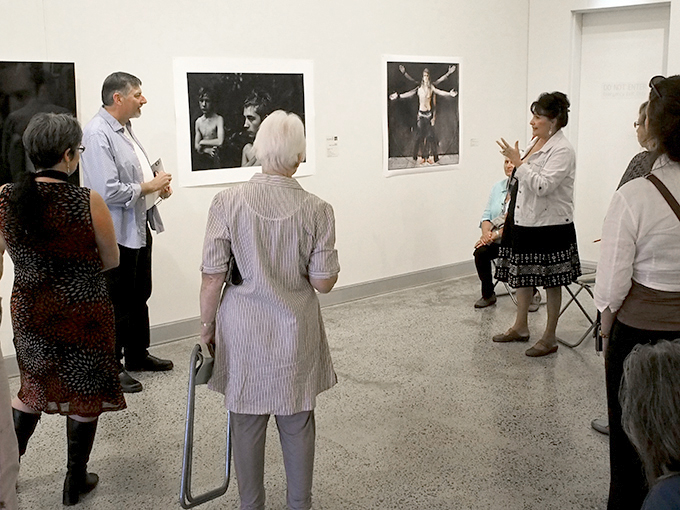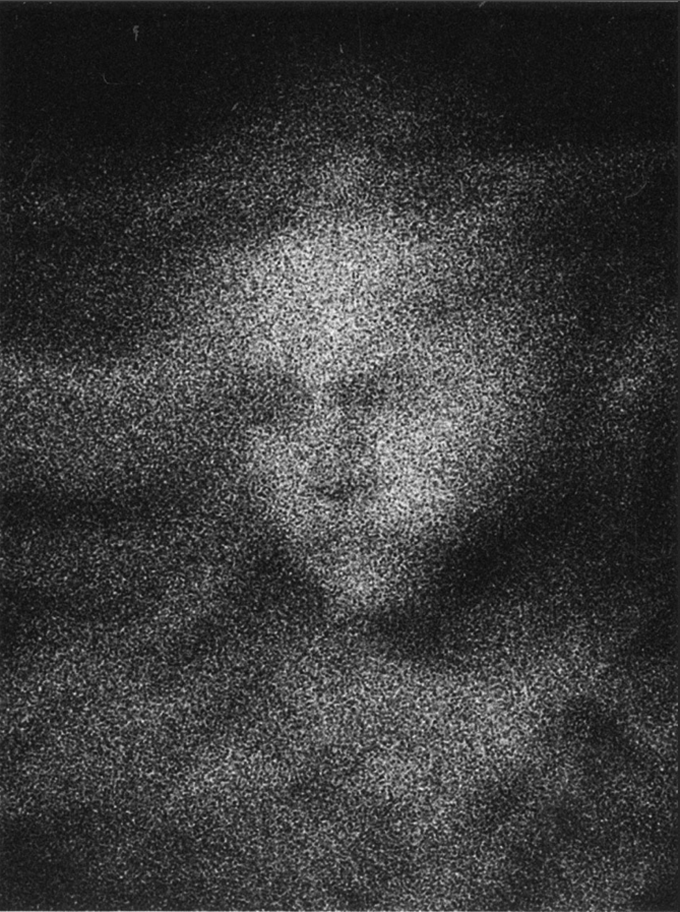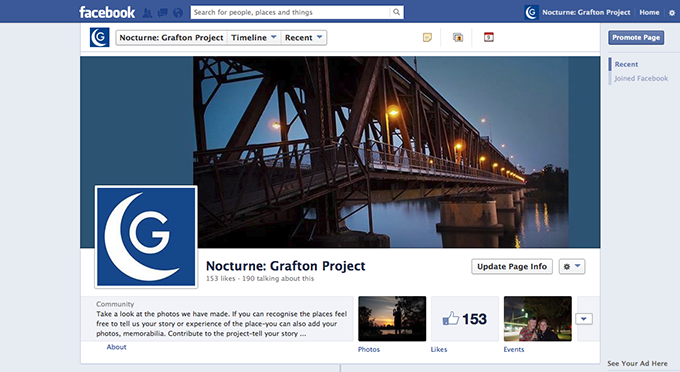Archive for the ‘Leap of Faith 2013’ Category
MAUD GALLERY CAMERA OBSCURA – for one day only
As a final event for Maud’s Festival of the Darkroom on November 26 between 12.00 Noon and 4.00pm we worked with Louis Lim to convert the Maud Gallery front room into a public Camera Obscura. We invited members of the Brisbane photo community to join with us for a look back to the origins of photography.
What follows are photos from the event…
Set-up day with Louis Lim, Ana Paula Estrada and Gillian Jones

The Maud camera obscura team – Louis Lim, Doug+Vicky with Maud Director Irena Prikryl. PHOTO: Louis Lim
Cooper+Spowart: 16 years of Camera Obscura Collaborations
In our collaborative work, we are interested in both the physical construct and cultural conventions that inform and shape us. This includes the common rituals and structures that surround, support and transport us in our everyday lives. In this work we have extended the context of documentary photographic methodology to include the narrative potential of the camera obscura and architectural projections.
.
.
In the camera obscura work the viewer’s perception of the everyday is spatially challenged. The structures that can form camera obscura are everywhere, but some spaces present themselves as clearly suitable for the making. This could be a city office, a motel room, a country bathroom or even a car. Our work attempts to contextualize the experience of the camera obscura within a concept, space or site. Upon entering the darkened space, the viewer is initially displaced, as the familiar image of the everyday is dim and unrecognizable. Then after time spent in the camera obscura, the image becomes clearer and the familiar is re-established ultimately resulting in a relocation of the observer’s awareness of place.
.
.
.
Some background on the set-up for the Travelodge camera obscura:
Simple black garbage bags and some black electrical tape from the local 711 store. An aperture cut from a ‘found’ piece of aluminium – size around 8mm … we don’t use sophisticated glass lenses – these are direct light projections. A digital camera bares witness to our experience by capturing the image of the camera obscura projection.
.
.
.
OUR MOST RECENT CAMERA OBSCURA: ORPHEUS ISLAND BEACH TENT
(A collaborative event with John de Rooy, Spyder Displays and the Orpheus Is Photo Workshop)
TO VIEW OTHER CAMERA OBSCURA WORK BY COOPER AND SPOWART SEE THE LINKS
.
Our Website:
http://www.cooperandspowart.com.au/4_PROJECTS/RoomCameraObscura-Project.html
Our car converted into a camera obscura and driven across Australia:
http://www.cooperandspowart.com.au/4_PROJECTS/CarCamera-Project.html
Two New Zealand Camera Obscuras in the the Queenstown Rydges Hotel:
https://wotwedid.wordpress.com/2012/05/07/two-new-zealand-camera-obscuras/
A public Camera Obscura performance and live video:
https://wotwedid.wordpress.com/2013/04/22/camera-obscura-pinhole-event-foto-frenzy-a-report/
YouTube videos:
http://www.youtube.com/watch?v=lyA5QP-mX-E
A camera obscura at the Queenstown Centre for Creative Photography:
https://wotwedid.wordpress.com/2012/05/07/camera-obscura-qccp/
A World Pinhole Day Camera Obscura at Mt Barney:
https://wotwedid.wordpress.com/2013/04/29/world-pinhole-photography-day-our-contribution/
.
.
© 2013 Victoria Cooper and Doug Spowart for 16 Years of Camera Obscuras Project
..
.
This work is licensed under a Creative Commons Attribution-NonCommercial-NoDerivs 3.0 Unported License.
.
.
MEMORY COLLECTIVE: Super Moon + Phoenix
Eighteen months ago Toowoomba artist Damien Kamholtz began a project that was to bring together a team of local artists to participate in a conceptual artwork that would have many states and private and public iterations. The first public presentation of the The Memory Collective was at the Toowoomba Regional Art Gallery in August/September 2013.
.
Two weeks ago a key element of The Memory Collective project was altered yet again into a new state. This took place near Cabarlah at a symbolic time for Kamholtz, the recent super moon…
.
Here is part of the document made on that July evening.
.
.
.
.
.
.
.
.
.
..
.
.
.
.
.
Aftermath of the fire
.
…. this is not an ending for the Memory Collective…
.
THE BACKSTORY OF THE MEMORY COLLECTION
.
An exhibition of the collaborative artwork as a singlarity
.
.
A painting and a performance
.
The Memory Collective is a multi-disciplinary collaboration orchestrated by artist Damien Kamholtz. Kamholtz states: The Memory Collective Project is a creative collaboration between 12 artists across eight artistic disciplines exploring concepts and themes relating to the human condition such as change, constants, history, refection and memory. The artworks created during the project will make up an exhibition to be held at the Toowoomba Regional Art Gallery in September 2013.
There are different stages to the project. First Kamholtz created a large 2.2 metre square painting, while sculptor, Jessie Wright constructed the large vessel to hold the water. Kamholtz’s painting is embedded with personal meaning in the form of fragments of his past art, the ashes of diaries. In the presence of this artwork we are drawn into a poetic landscape where faces emerge; symbols and totems slip from passive dark spaces and come into conscious awareness.
The second stage of the work was the performance in the form of 9 responses to the painting by Kristy Lee. The painting and the pool created the reflective and reflexive performative space and the transformative process of the original painting then began. Integral to the space were David Usher’s delicate pots; these vessels contained the pallet of shades that then shrouded and clouded the memory of the work. Over the course of the day the painting’s physical form was transformed into something different loosing its current visual form as only a memory.
Our part of the collaboration was to witness, respond and record the transformation of the work over the day. The next stage of the Memory Collective’s work will continue over the next month our component will be to create 9 large collaged photograph memory states of the work for the show in September. Works by others include; a video art piece, a documentary video, a soundscape, interviews, prose and poems. It is a significant project and is being funded by the RADF and supported through the exhibition at the Toowoomba Regional Art Gallery.
.
A fragment of photographic memories made by us for the MEMORY COLLECTIVE…
.
.
.
A performance
..
…
.
.
.
.
.
.
.
.
.
…
.
.
Additional material
/.
.
.
Another creative work from the performance by Jason Nash…
CLICK HERE to see Jason Nash’s ‘Memory Collective’ time-lapse video
.

The Team: Front Ashleigh Campbell, Julio Dunlop, Kirsty Lee, Victoria Cooper, Doug Spowart
Back: David Usher, Jason Nash, Jesse Wright, Damien Kamholtz, Zac Rowling ( weakling).
Not present: Craig Allen & Jake Hickey
.
.
..
.
© 2013+2014 Victoria Cooper and Doug Spowart for The Memory Collective
.
This work is licensed under a Creative Commons Attribution-NonCommercial-NoDerivs 3.0 Unported License.
.
.
2013-14 NEW YEARS EVE FIREWORKS: Frogs Hollow – Toowoomba
.
NEW YEAR’s EVE – A time for freedom from order — a time for fun.
.
So we left the big cameras at home and went out with the little Olympus Pens point-n-shoot. No tripod – no big plans – “Bulb” setting, watch, mingle, be a part of the ‘BANG’, ‘Crackle’, ‘POP’ and the gasps and murmur of the crowd.
.
These are truly experiments in capturing the experience and essence of a fireworks display in regional Australia … Enjoy!
And all the very best to you for the New Year!
.
Click on any image for it to enlarge …
.
.
.
© 2014 Victoria Cooper and Doug Spowart
.
This work is licensed under a Creative Commons Attribution-NonCommercial-NoDerivs 3.0 Unported License.
.
.
CAMERA OBSCURA 2000–2020: In hotels and other places
.
Our rhythms insert us into a vast and infinitely complex world, which imposes on us experience and the elements of this experience. Let us consider light, for example. We do not perceive it as a waveform carrying corpuscles but as a wonder that metamorphoses things, as an illumination of objects, as a dance on the surface of all that exists.…………
Henri Levebvre, Rhythmanalysis; Space, Time and Everday Life, page 82.
.
Cooper+Spowart: 20 years of Camera Obscura Collaborations
In our collaborative work, we are interested in both the physical construct and cultural conventions that inform and shape us. This includes the common rituals and structures that surround, support and transport us in our everyday lives. In this work we have extended the context of documentary photographic methodology to include the narrative potential of the camera obscura and architectural projections.
.
.
In the camera obscura work the viewer’s perception of the everyday is spatially challenged. The structures that can form camera obscura are everywhere, but some spaces present themselves as clearly suitable for the making. This could be a city office, a motel room, a country bathroom or even a car. Our work attempts to contextualize the experience of the camera obscura within a concept, space or site. Upon entering the darkened space, the viewer is initially displaced, as the familiar image of the everyday is dim and unrecognizable. Then after time spent in the camera obscura, the image becomes clearer and the familiar is re-established ultimately resulting in a relocation of the observer’s awareness of place.
.
.
.
.
.
.
Some background on the set-up for the Travelodge camera obscura:
Simple black garbage bags and some black electrical tape from the local 711 store. An aperture cut from a ‘found’ piece of aluminium – size around 8mm … we don’t use sophisticated glass lenses – these are direct light projections. A digital camera bares witness to our experience by capturing the image of the camera obscura projection.
.
.
.
OUR MOST RECENT CAMERA OBSCURA: ORPHEUS ISLAND BEACH TENT
(A collaborative event with John de Rooy, Spyder Displays and the Orpheus Is Photo Workshop)
TO VIEW OTHER CAMERA OBSCURA WORK BY COOPER AND SPOWART SEE THE LINKS
.
Our Website:
http://www.cooperandspowart.com.au/4_PROJECTS/RoomCameraObscura-Project.html
The porthole on the Spirit of Tasmania Ferry
https://wotwedid.com/2019/01/11/2018-field-studies-camera-obscura-spirit-of-tasmania-porthole/
Our car converted into a camera obscura and driven across Australia:
http://www.cooperandspowart.com.au/4_PROJECTS/CarCamera-Project.html
Two New Zealand Camera Obscuras in the the Queenstown Rydges Hotel:
https://wotwedid.wordpress.com/2012/05/07/two-new-zealand-camera-obscuras/
A public Camera Obscura performance and live video:
https://wotwedid.wordpress.com/2013/04/22/camera-obscura-pinhole-event-foto-frenzy-a-report/
YouTube videos:
http://www.youtube.com/watch?v=lyA5QP-mX-E
A camera obscura at the Queenstown Centre fro Creative Photography:
https://wotwedid.wordpress.com/2012/05/07/camera-obscura-qccp/
A World Pinhole Day Camera Obscura at Mt Barney:
https://wotwedid.wordpress.com/2013/04/29/world-pinhole-photography-day-our-contribution/
.
.
© 2019 Victoria Cooper and Doug Spowart for 20 Years of Camera Obscuras Projects
..
.
This work is licensed under a Creative Commons Attribution-NonCommercial-NoDerivs 3.0 Unported License.
.
.
































